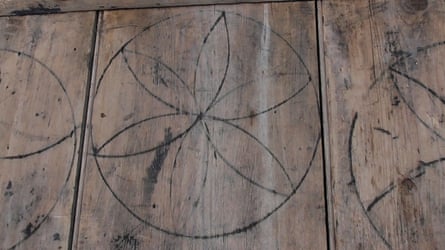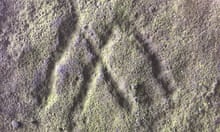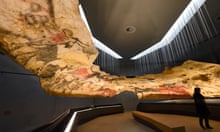The public is being encouraged to help map Britain’s historic obsession with the paranormal by searching for ancient scratchings in old buildings, used as charms against witchcraft and evil spirits.
Historic England would like help to find more of the marks, typically concentrated around entry points seen as vulnerable such as windows, chimneys and doorways.
Faint symbols have been recorded in buildings and sites across England, including Shakespeare’s birthplace in Stratford-upon-Avon, the Tower of London, and Wookey Hole caves in Somerset – where a tall stalagmite has been shown to tourists for centuries as the petrified body of a witch.
The patterns include flower-like designs made with compasses and dividers, pentangles, intertwined Vs and Ms for the Virgin Mary, and tangles of lines which it was believed confused spirits who attempted to follow them. Tadpole-shaped scorch marks made with a candle flame have also been found.

Historic England’s historic buildings inspector, Nick Molyneux, said: “More efficient oil lamps in the 19th century seem finally to have banished witches. We see them from the 16th century on, often in buildings already centuries old, but there could well be earlier and later marks that just haven’t been recorded.”
Molyneux, who spotted a mass of marks on the mantelpiece of an old timber-framed house in Warwickshire this week, recorded witches’ marks at Shakespeare’s birthplace several years ago, on timbers of the staircase leading to the cellar. He said: “They possibly date from the period when the house became a pub, and the beer would have been stored there. You certainly wouldn’t have wanted witches turning your beer sour: that really would have been a disaster.
“Basically the marks have been recorded where people have taken the trouble to go and look for them. They are well recorded in many churches, but much less well so in secular buildings. We just don’t have enough data to say whether they are more concentrated in certain parts of the country, or whether patterns are regional, so these are questions we would really like help in answering.”
Confusingly, carpenters’ marks indicating how the timbers should be assembled, masons’ marks, and doodles by bored apprentices are often found in the same buildings or even on the same timbers and stone.

The marks coincide with a period when most interiors lit by rush lights or tallow candles would have been extremely dark once night fell, and when belief in witchcraft and trials of unfortunates accused of it were at their height. The first specific law against witchcraft was only introduced under Henry VIII in 1542, and in the 17th century, James I was preoccupied with witchcraft and wrote a treatise on the subject. Recent conservation work revealed a mass of witches’ marks carved into the timbers of rooms which were prepared for his visit at Knole, a palatial house in Kent now owned by the National Trust.
The last woman jailed for witchcraft in England was Scottish-born Helen Duncan, a medium arrested while holding a seance in 1944, and accused of betraying war secrets. She was prosecuted for fraud and witchcraft, and served nine months in Holloway prison.
The witches’ marks are properly known as apotropaic marks, from the Greek word for avoiding evil.
Duncan Wilson, chief executive of Historic England, said: “They really fire the imagination and can teach us about previously held beliefs and common rituals. Ritual marks were cut, scratched or carved into our ancestors’ homes and churches in the hope of making the world a safer, less hostile place.”



